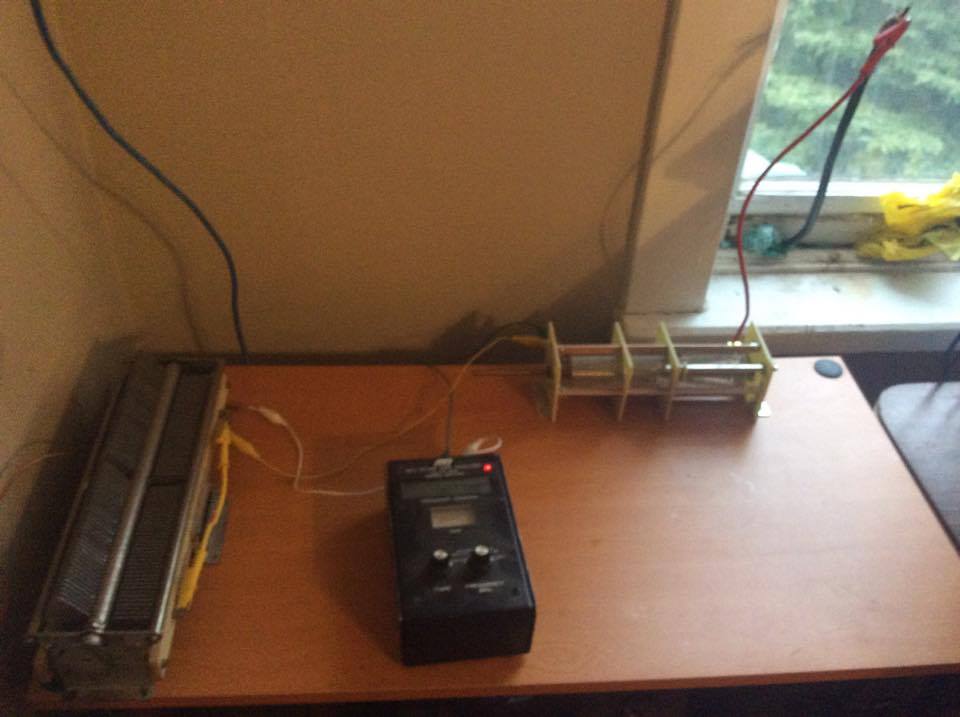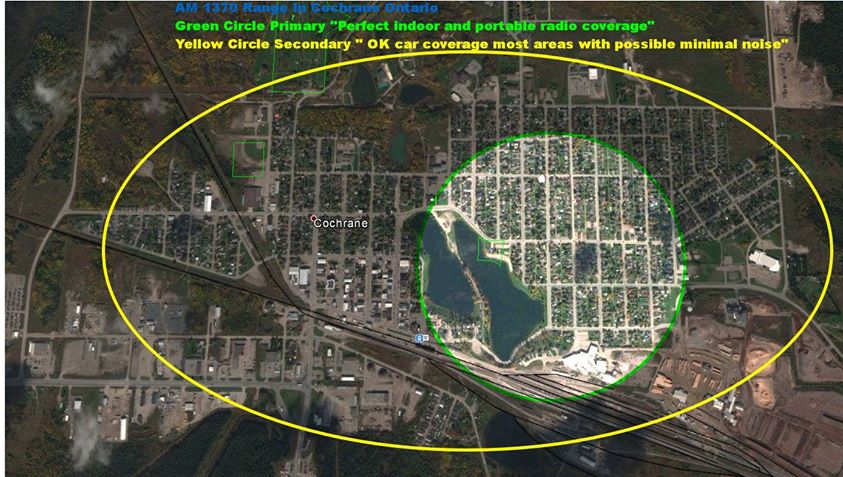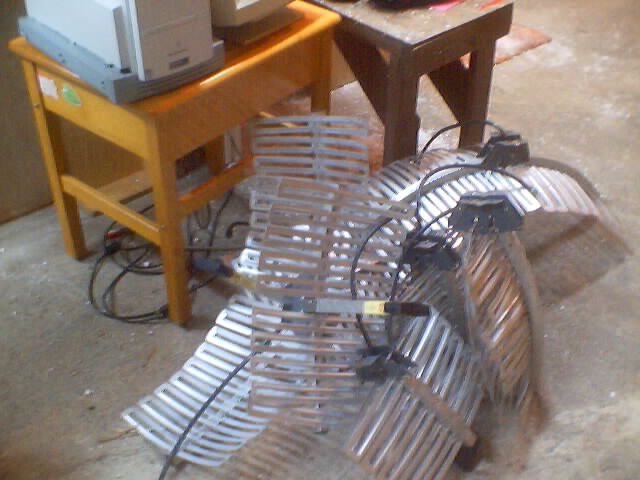
Over the years since I was a teenager I have
been a licensed ham radio operator. Unfortunately today I
consider myself non active as there are no longer any other
active members in
my ham radio location grid. During my teen years and early
adulthood I was very much active in ham radio. Also completing
my CO-OP at the time with our local radio station
technical team. I learned most of what I know about radio and RF
during those times and I would like to share with you some of my
understandings along the way!
 Table Of Contents
Table Of Contents
My profound interests in the low frequency
bands started when I was very young and noticed some
irregularities only on the "shortwave" bands. Once I got my ham
radio license at
16 years old. I learned about the whys and hows regarding radio.
My issue then with the low bands. I did not have the space for
such big antennas. Usually required to work very low
frequency bands, I researched and pondered. Experimented with
various short antennas. Let me tell you. Don't let any
"old" fashioned ham radio tell you that you can not work low
frequency, such as 160 meters with very short antennas using low
power. My personal experience dictates 100% against these
generic ham statements.
These just seem to work. A tuned L/C
circuit. It is over "sized" Has a huge capacitance hat. and
radiates "leaks" better then a "dummy" load. These work more
like "Tesla" coils.
These antennas operate in the impedance zone of High Q. These
are very high voltage generators as well and a general issue
with any "High Q" short antennas.
I built one indoors around a plastic (PVC) fat vent that crossed
the floors. I will include some resources and information
related to the CFA later on in the links and resources
section of this page near the bottom.
This tiny indoor antenna did great at
ground-wave and sky wave propagation on 40 meters. I was even
able to do regular QSO's (contact) with my friend VE3TEO located
some
miles away. No more then 25 watts was ever used indoors. The
high voltage potentials had me worried, hanging around this
antenna or running any kind of serious power behind it.
Pondering.... If only the Commercial AM
broadcasters knew. Big AM phased antenna fields are not
really required , Very expensive to build and maintain.
CFA Antenna

I reasoned that with the additional help of
a radio L/C network. I should be able to tune the ground shield
of a 100 feet run of coax as a random wire antenna, Going around
the
backyard. Randomly around things, up tress and such. I tried
this method. It looks like a crude setup. How-ever. I found the
simplicity to be of a sweet value. Finding resonance
is just a matter of turning the knobs of the L/C until the
transmitter final stage hits a peek current draw at the point of
resonance. Or just by using a SWR analyzer. Much easier
with an SWR analyzer. This was a method of getting on HF
temporarily in a city "lot".
L/C setup

I was very surprised that by following the same L/C network
principles, I was able to build a loop antenna the followed
along the whole side of one of the 4 concrete walls of a deep
basement for 160 meters. This worked interestingly. I was
able to hear a CW tone 6 miles away on a portable radio
receiver. The transmitter only had 5 watts of power
running
on 160 meters CW mode. I was happy to have the assistance of my
friend Bill VE3WIL at the time of experiment.
The basement setup was rather simple.

This was on one side of my walls.
I saved this one here for last as you need
a medium sized lot to be able to experiment with such an
antenna. Performance
was the best with this kind of setup. I was lucky and able to
use an old clothing line between the two lots. No one bothered
me with such a setup, as it was out of the way. Not everyone is
lucky and able to install this type of antenna.

It is best to keep the angle of the
horizontal section as close to 90 degrees as you can to avoid
loss in performance. I had to run an
insulated supporter half way. To keep the angle as close to 90
degrees as possible.


I have early experience in the field of FM
broadcast and VHF as well. Thanks to our at the time local VE3AA
Timmins Ham Radio Club and my involvement with local radio
station
on FM. I later on ventured into a non for profit radio club. I
more or less was the head project organizer. Our team managed to
get a radio license from the CRTC to operate a community
radio station in Iroquois Falls. Ontario. As a non for
profit. The station ran its course. Until the license was up for
renewal. Unfortunately for many reasons out of my direct
control. It
was then determined by the group. that it was for our best
interest of our members personally . To not renew the license.
I consider the project a success. I am thankful as I
learned from
this experience. Many years, Folks had a local alternative
source to local programming news and emergency broadcasts. By
using our community station as a local outlet. As far as
keeping us all connected. This kind of radio service is no
longer really needed in 2021. We have social media. Our phones.
Our apps. Our podcasts. Just about everything but analog radio.

The FM Broadcast hardware chain.
I'm proud of having been the one
to hook this up! A very professional
installation. For the community radio
station in Iroquois Falls. We where a
non profit local club.
I also volunteered my part within
our ham radio club as well. Back in the better days of ham
radio. I was the elected club Treasurer for a term. I enjoyed my
volunteer experience with
VE3AA. We worked many projects together. Including tuning of
antennas, Installation of VHF repeater systems. We also enjoyed
APRS and Echolink. D-Star came later on.
 Tuning of ham repeater antenna near Timmins.
Tuning of ham repeater antenna near Timmins.
The 2 meter repeater in Timmins operated on 147.060 + Don VE3HOL
is standing to the right in black.
Here is the view! Photos taken by me.

I enjoyed ham radio for several years until
our club members declined from lack of interest as new and
better tech came along.(Smart phones and such)
Also many members over time, moved away. The average ham
operator around here have mostly been retired for years before.
Many of them.
My friends regretfully have passed of natural causes. One
of those ham operators I have great respect for. he since
then passed away as well.
Don VE3HOL. He was president of the club for a while.We worked
together. He we a very knowledgeable man with an advanced and CW
classification license. He we also our local ham radio examiner.
I spoke to him just a couple weeks before he passed. All seemed
well. I had inquired
in an earlier email sent to him. If he remembered the original
VE3AA club Packet Radio Network. I wondered how it operated as
this was before my
time as a ham operator. I didn't expect it. He sent me a full
historical breakdown. It was very informative and historic. I
will include the email response
right here for memorial reasons. And to share a piece of Timmins
ham radio history.
Email:
I think you had asked me about local packet
back in the good-old-days! I took over running the
data network after Bert, VE3DPZ retired from it.
Each packet node needed a dedicated box running a packet
forwarding software. In our case, we ran a program
called “MS-DOS” on the fastest
Dos version we could find! There were other
forwarding software, FBB was one of them but we used
MS-DOS. When I took over, our box was
up on TV hill behind your place. I had to contend with
your Friend Norm(VE3UHY) for access to the box! Our
traffic came from Quebec into
a North Bay box. We had a ham in Temagami who was able to
receive the North Bay signal and was able to transmit INTO our
box on TV hill.
No internet back then! The packet address had the call sign of
the recipient and knew where his home QTH was. The
packet address also knew
when delivery was successful. Number of retries was one of
MS-DOS’s configurations option. On good links you could
set it to 2…on bad links
to 3 or maybe even 4. If you set too high, it would slow
the whole download down! Set too low and some packets
would wind up in the garbage!
When TARC expanded to the corner of 655 and highway 11 at
Driftwood with box VE3TIR, it became possible for a
direct connection to
Kaspukasing. Some hams in Kap decided to build a box
for packet. All traffic for the North was directed to
Timmins from Temagami. Traffic for
Kap was then forwarded from Timmins. This was done
automatically.
My Ham Radio Corner
Yep those were the good old days!!!! Sometimes…not so good!Ha Ha
Don
I grew up in the country some miles away from town. It was lucky
if we got spontaneous dial-up internet to connect from our old
POTS service lines. The provider has failed to upgrade
even to this day. Today people who live around that area. Simply
use the cell phone high speed data connection as a hotspot , for
access to "high speed" internet. Before the cell phone data
days. Options for high speed internet where limited. Those
Times, I lived with my parents. If you literally did not live on
the "Main Street" downtown. You where out of luck.
When I was around 15 years old. Bill VE3WIL
and I decided to experiment with some ISA wireless Cards that he
picked up at the Ham Show in Dayton. We installed the system.
One system
on top of his 64 foot tower downtown Iroquois Falls. And another
antenna at my place about 6 miles away, at around the same
height. It took multiple tries and even some hops to get us
where
we wanted. But within a couple weeks. We had figured out the
wireless network configurations that would suit us best. I ran
many years from this internet. And we shared to a handful
of our friends who lived around who also enjoyed high speed
internet.
An interesting observation.
*With trial and error. I came to notice
that as far as getting point to point links to operate in near
line of sight settings on the 2.4 ghz microwave band.
turning down the radios to
operate only in 1mbps "B" mode. This opened up the radio to
the most noise tolerance. And good operation with low signal
(rssi) levels. This "trick" also did us good in situations
where we did not have perfect line of sight. If all you
require is around 1mbps. This is/was a great solution!

We used these old grids that where
previously used on a local MMDS system. Wireless Cable, It was.

This was the equipment in town. One of
those 2.4 Ghz panels, Is pointing to my house!!
We used Smart Bridges equipment at the time. The "Air Point Pro"
and Air Bridge Pro.